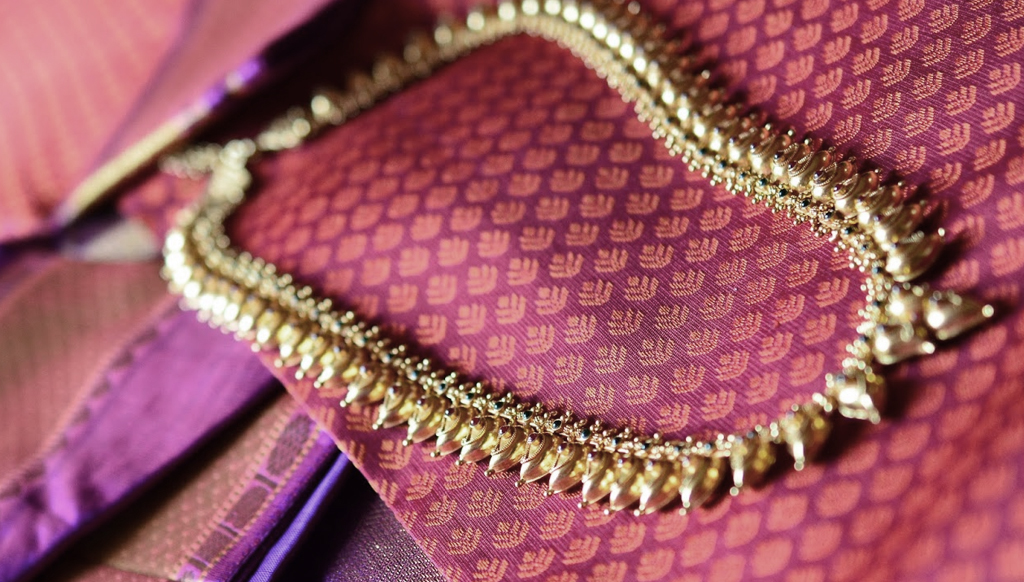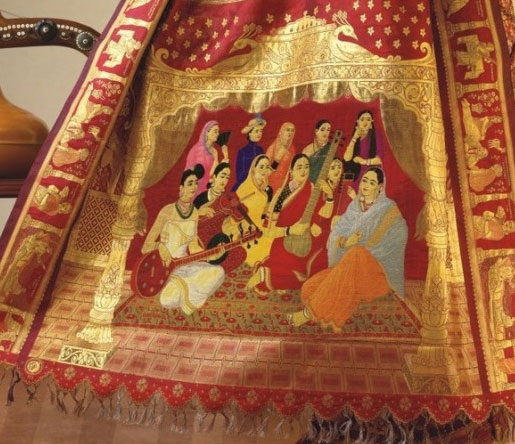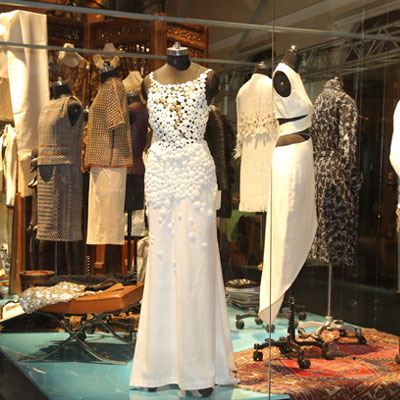
Reconnect with your family heritage while making a unique
style statement
In a life less ordinary, a beautiful Maharani with a keen appetite for luxury and intrigue ordered gold tongue-scrapers from Van Cleef & Arpels. But that was just one fleeting detail in the extravagant life of Maharani Sita Devi of Baroda. Apart from a bold personal style and a scandalous second marriage,Maharani’s story involves the Baroda pearls (mysteriously missing several of its strands when it was auctioned at Christie’s for $39.1 million), a 34-carat pink diamond named after her son, and a whole lot family royal jewels discreetly reset in platinum. Long after her death, Sita Devi lives on in the popular imagination through the lore of her jewels.
The old splendor of the Maharajas may have lost some of its shine, but our fascination with heritage will always define our style, in fact now more than ever. So if you have caught yourself admiring a sepia photograph of your elegant grandmother (with a serrated edge and embossed gold lettering), demurely posing for a studio portrait—chances are, you are about to raid her treasure chest (or almirah).
Allow us to take you on a journey to reconnect with your family heritage while making a unique style statement. Soak in some of that serene glamour—something other than the accurate colors of the season, ombre georgettes, zari, pearl and crystal embroideries on net and silk. Something other than the carefully orchestrated and airbrushed designer looks.

Most prominently, you will discover beautiful textile pieces in varying states: from the very well-preserved to the nearly decomposing. Depending on where your grandmother came from, you might find a collection of sarees: gorgeous Kanjeevarams from Tamil Nadu, delicate Jamdanis of Bengal, elegant geometric double ikats—Pochampally from Andhra Pradesh and Patola from Gujrat. Banarasi brocades with real gold and silver zari is a very special find, as would be anything with real gota patti work. If you have roots in North India, the treasure hunt may yield an exquisitely worked chikan on cotton or silk, or an intricately worked zardozi lehenga.
You can give a new lease of life to a ruined brocade or jacquard saree by getting the motifs appliqued on to a fabric to create a new style—try simple silhouettes like oversized shirts, shirt-jackets, wrap shirts or dresses.
![]() The great thing about unstitched textiles is that they are versatile—undamaged sarees and dupattas can be used as it is (and they don’t need alteration!), while pieces which have damaged areas may be incorporated in new customised garments and accessories—in necklines and collars for Indian and Western Silhouettes, as borders for dupattas and sarees, or for small purses and handbags—since it is easy to reinforce them with a strong backing. You could also manage to cleverly manipulate the intact fabric to create a beautiful saree blouse. You can give a new lease of life to a ruined brocade by getting the motifs appliqued on to a fabric to create a new style—try simple silhouettes like oversized shirts, shirt-jackets, wrap shirts or dresses.
The great thing about unstitched textiles is that they are versatile—undamaged sarees and dupattas can be used as it is (and they don’t need alteration!), while pieces which have damaged areas may be incorporated in new customised garments and accessories—in necklines and collars for Indian and Western Silhouettes, as borders for dupattas and sarees, or for small purses and handbags—since it is easy to reinforce them with a strong backing. You could also manage to cleverly manipulate the intact fabric to create a beautiful saree blouse. You can give a new lease of life to a ruined brocade by getting the motifs appliqued on to a fabric to create a new style—try simple silhouettes like oversized shirts, shirt-jackets, wrap shirts or dresses.

You might also come across some stunning bandhini and lehariya which may be updated as a dress detail or border, if damaged. Vibrant kutch embroidery with its geometric shapes and mirrors, can be incorporated as a detail or a centre-piece in a new garment or even patched on to a favourite denim jacket. The list goes on: detailed and tactile Kantha work, Kashmiri stitch, precious Parsi borders, flamboyant fulkaris and pipli, subtle kasuti—all of these can be used and added on for amazing effects. If you are lucky and the wardrobe has been regularly aired, you might find shawls. A plain pashmina shawl or a Naga shawl are easy enough to wear in any wardrobe, while the discovery of a Kani Jamawar should be treated as a special occasion. In the days of royal patronage, these were created exclusively for the aristocracy, the jacquard pattern so skillfully woven that it was impossible to tell the wrong side from the right.
Often, you may find home textile pieces. These, too may be brought back to use as home accents. However, a great way to incorporate them in your life is to get them mounted and framed. This will improve their longevity and visibility as well. The main beauty of all these finds is that the craftsmanship is so exquisite, the materials precious and handmade, and the color palettes so much more subtle and sophisticated, more inspired by nature than their present-day descendents.
Brooches can perk up many a drab and monochromatic outfit. More delicate silver pieces look fantastic with block-printed ethnic ensembles or separates.
![]() Besides these more perishable pieces, you may also stumble upon other interesting items, such as hand-fans and book-jackets—which again will do well in home decor. Shoes are a rare find, as mostly they get worn out, but if you are lucky, you might find a ceremonial or decorative pair of jootis. While it is unlikely that any gold jewellery would be locked away waiting to be discovered, silver and gold-plated jewellery might surface. Brooches can perk up many a drab and monochromatic outfit. More delicate silver pieces look fantastic with block-printed ethnic ensembles or separates. However, chunky silver coins, amulets, armbands and cuffs can work with long and voluminous western silhouetted, creating an edgy, contemporary aesthetic.
Besides these more perishable pieces, you may also stumble upon other interesting items, such as hand-fans and book-jackets—which again will do well in home decor. Shoes are a rare find, as mostly they get worn out, but if you are lucky, you might find a ceremonial or decorative pair of jootis. While it is unlikely that any gold jewellery would be locked away waiting to be discovered, silver and gold-plated jewellery might surface. Brooches can perk up many a drab and monochromatic outfit. More delicate silver pieces look fantastic with block-printed ethnic ensembles or separates. However, chunky silver coins, amulets, armbands and cuffs can work with long and voluminous western silhouetted, creating an edgy, contemporary aesthetic.
Storage and care of these precious objects is not to be taken lightly. Just a few helpful hints:
- Store away from moisture and light
- Air regularly
- Do not wrap in ordinary paper; use muslin or acid-free paper to avoid further damage
- Use a professional cleaner that you trust; the wrong chemicals can destroy textiles instantly
Lastly, in case you have discovered a really beautiful piece which is damaged, and you are unable to use it or preserve it at home, please donate it to an interested public or private museum, so it is able to tell its tale to those who are waiting to hear it.
Oh, and about that photograph. Don’t put it up on your wall. Old photos are fragile, and must be stored away from light in archival photo sleeves. Frame a digital print and place it on your favourite wall, along with your framed pieces of heritage.










